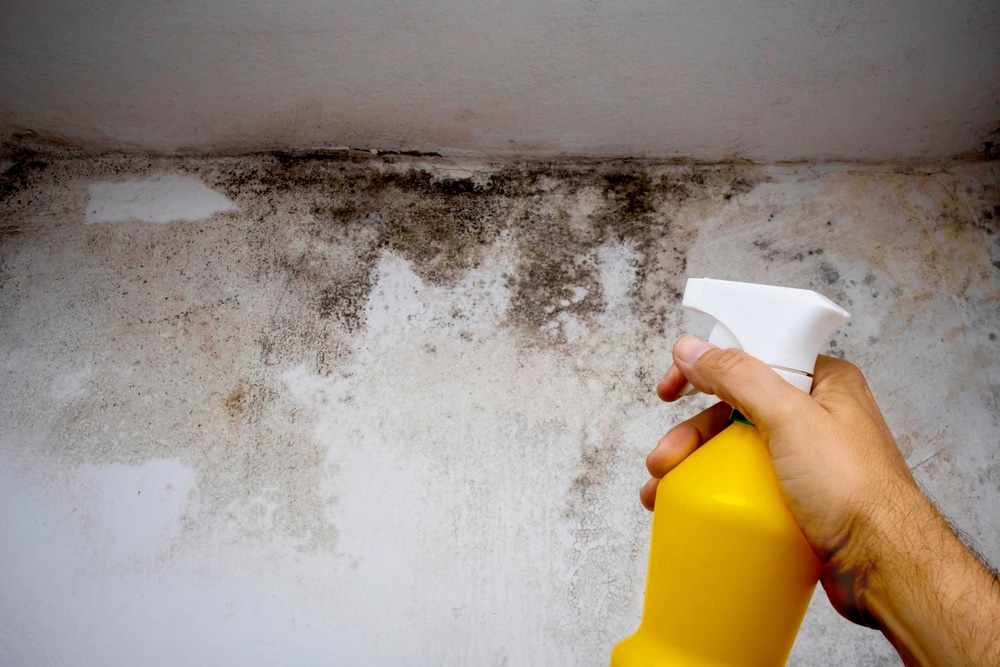Is a faint musty odor in a bathroom or basement a minor nuisance—or the start of damage that spreads beyond the walls?
Stachybotrys chartarum grows well on damp drywall, wood, and wallpaper. It thrives when humidity is high. Within 24–48 hours after a leak or flood, it can start growing. Its spores can spread through air vents and behind paint.
The question—What happens if black mold is left untreated?—is important. Small patches can hide larger, hidden colonies.
Ignoring mold can lead to more than just a bad smell. Materials can weaken as mold breaks down fibers. Musty odors often mean mold is growing in walls or ducts.
For some, mold can cause sneezing, watery eyes, and asthma attacks. These indoor mold dangers get worse over time. They increase health risks and repair costs.
The Centers for Disease Control and Prevention say to remove mold, no matter the type. Testing can slow down action. Quick cleanup limits untreated mold effects.
Knowing the full impact of black mold consequences helps us take action. It shows why mold remediation importance is key.
Key Takeaways
- Black mold can start growing within 24–48 hours after moisture intrudes.
- Hidden colonies in walls and ducts often accompany a musty odor.
- Health effects range from allergy symptoms to asthma flare-ups in sensitive people.
- Untreated mold effects include weakened building materials and higher repair costs.
- CDC guidance favors prompt removal over testing, in damp areas.
- Early action reduces the mold growth impact and highlights mold remediation importance.
Black mold basics and why indoor mold dangers escalate when ignored
Black mold basics start with biology and sight. Stachybotrys chartarum often looks black or dark green. It has a slick or slimy surface on wet drywall, cardboard, or wood. It gives off a strong musty, earthy odor from mVOCs, a cue that moisture and spores are present indoors.
Growth follows simple rules: moisture, an organic food source, oxygen, and mild temperatures around 40–100°F. Relative humidity at or above 70% speeds colonies on walls, ceilings, and trim. Leaks, flooding, uninsulated windows, and poor ventilation in bathrooms, kitchens, basements, and crawl spaces drive the mold growth impact.
Time matters. After wetting, spores can germinate within 24–48 hours. Air currents move particles into adjacent rooms, behind walls, and above ceilings. This spread magnifies indoor mold dangers as surfaces stay damp and dust supplies food.
Not all dark spots are the same. Mildew is usually white and flat, turning gray or light brown as it ages. Mold is often darker, taller, or fuzzy. Black mold tends to look wetter with dot-like clusters near visible water damage, a pattern tied to untreated mold effects.
What happens if black mold is left untreated?
What happens if black mold is left untreated? It feeds on drywall, wood, insulation, and wallpaper glue. This process stains surfaces, causes musty smells, and makes paint peel off. Over time, it can soften studs, crumble corners, and hide damage in walls.
After a leak, spores can start growing in 24–48 hours. With constant humidity, mold spreads to ceilings, subfloors, and ductwork. Moisture in porous materials makes cleanup harder and more expensive the longer it waits.
Indoor mold dangers increase with time and exposure. People might cough, wheeze, have sore throats, or rashes. Those with asthma or allergies often feel tired, have headaches, or experience flare-ups.
Studies show long-term dampness can lead to new asthma cases and persistent breathing problems. Health agencies link damp homes to more illnesses. This shows the real-life effects of untreated mold.
Children, older adults, and those with certain health issues are at higher risk. For them, mold can cause severe attacks and infections. It’s important to stop moisture quickly to reduce these risks.
Damp rooms often have mold, bacteria, dust mites, and chemicals in the air. These substances stay in fabrics and vents, keeping smells and irritation going even after windows are opened.
Ignoring mold can lead to legal issues if homes are not safe to live in. In the UK, landlords have faced trouble for not fixing damp and mold. Similar concerns are growing in other cities as health effects become clearer.
Black mold health risks and the importance of timely mold remediation
Black mold can irritate your nose, eyes, skin, and throat. Symptoms include sneezing, runny nose, and itchy rashes. You might also cough, have a sore throat, or experience asthma flare-ups.
Children, babies, and older adults are at higher risk. People with asthma or allergies can also get very sick. In rare cases, mold can lead to serious infections like bronchitis or pneumonia.
Some people feel tired, have headaches, or trouble focusing after being exposed to mold. While “toxic mold syndrome” is not officially recognized, the effects on daily life are real. It’s wise to reduce dampness and visible mold growth.
Acting quickly is key to both health and cost savings. Any mold should be removed, not tested. Small areas can be cleaned up after fixing the moisture issue. But for bigger problems, it’s best to call in the experts.
- Control moisture first: repair leaks, improve ventilation, keep indoor humidity below 50 percent, and dry wet materials fast.
- Limit spread: seal the work zone with plastic, and wear an N95 respirator, gloves, and non-vented goggles.
- Clean hard surfaces with detergent and water, then dry well. In showers, a bleach mix of up to one cup per gallon of water can help; never mix bleach with ammonia, and ensure airflow.
- Use alternatives like white vinegar or reputable mold removers as directed; spot-test surfaces and seek professionals if growth persists or materials are penetrated.
- Discard porous items wet for more than 48 hours if they cannot be cleaned and dried; bag items before removal and use HEPA filtration in HVAC to capture spores.
To prevent mold, keep humidity under 50 percent. Vent bathrooms and kitchens well. Avoid carpet in damp rooms and dry wet mats. Fix structural problems like leaks and condensation with better insulation and airflow.
In the United Kingdom, Awaab’s Law sets strict timelines for social landlords to tackle damp and mold hazards starting in October 2025. This shows how institutions now prioritize swift action on mold issues that affect homes and health.
Conclusion
Black mold doesn’t stop growing on its own. It starts to spread quickly, within 24–48 hours, on damp surfaces. This leads to a musty smell, stains, and weakens materials, causing damage.
Health problems can arise from mold exposure. Symptoms include sneezing, coughing, and eye irritation. People with asthma or weakened immune systems are at higher risk. Infections can happen, even though some details about mycotoxins are debated.
Controlling mold starts with controlling moisture. Fix leaks, improve air flow, and keep humidity below 50%. Dry wet areas quickly and avoid carpets in damp places. For big mold problems, call in experts who know how to handle it safely.
The key is to act fast to avoid bigger issues. Mold can harm air quality and lead to expensive repairs. Quick and thorough cleaning, along with controlling moisture, is essential. This protects your home and health from mold dangers.






